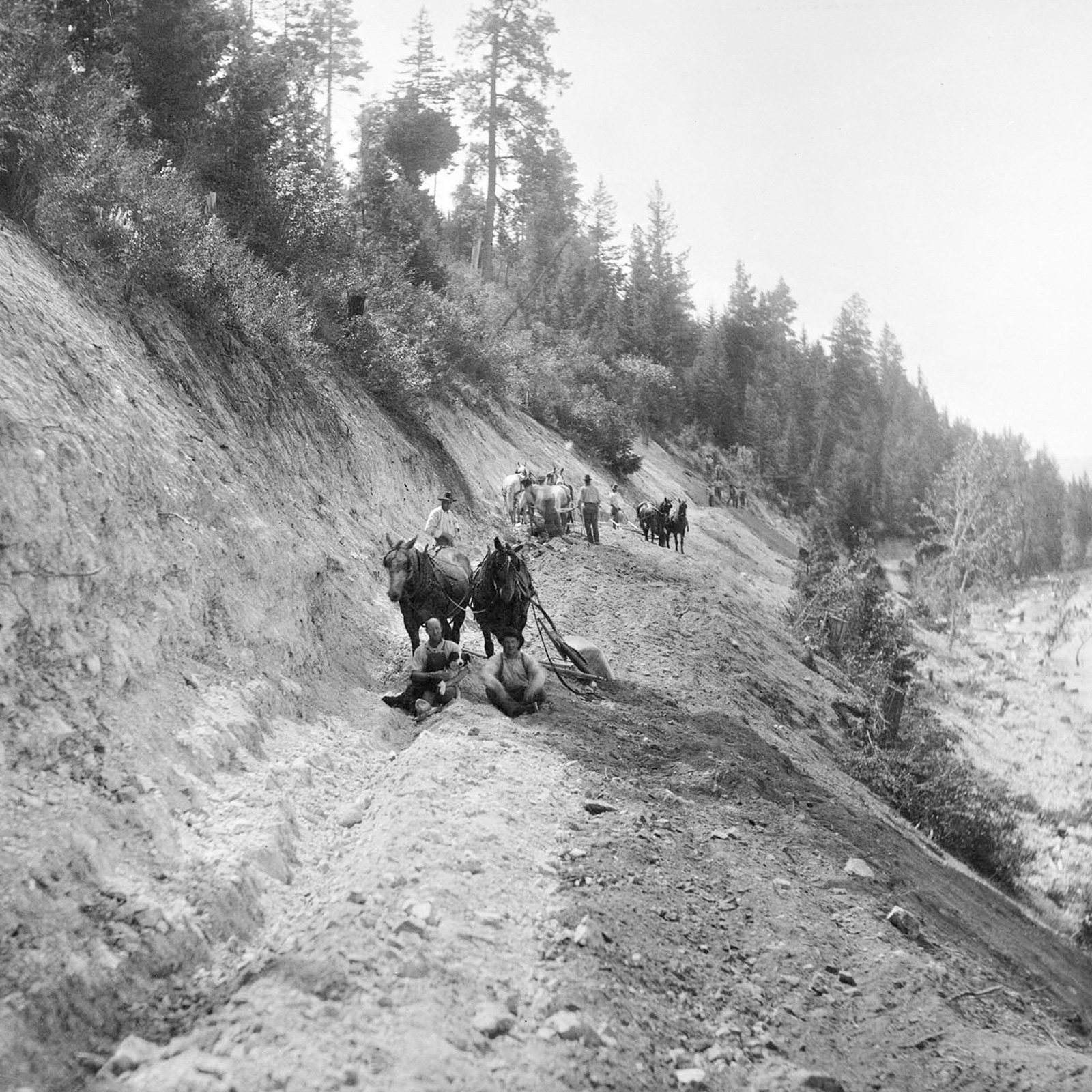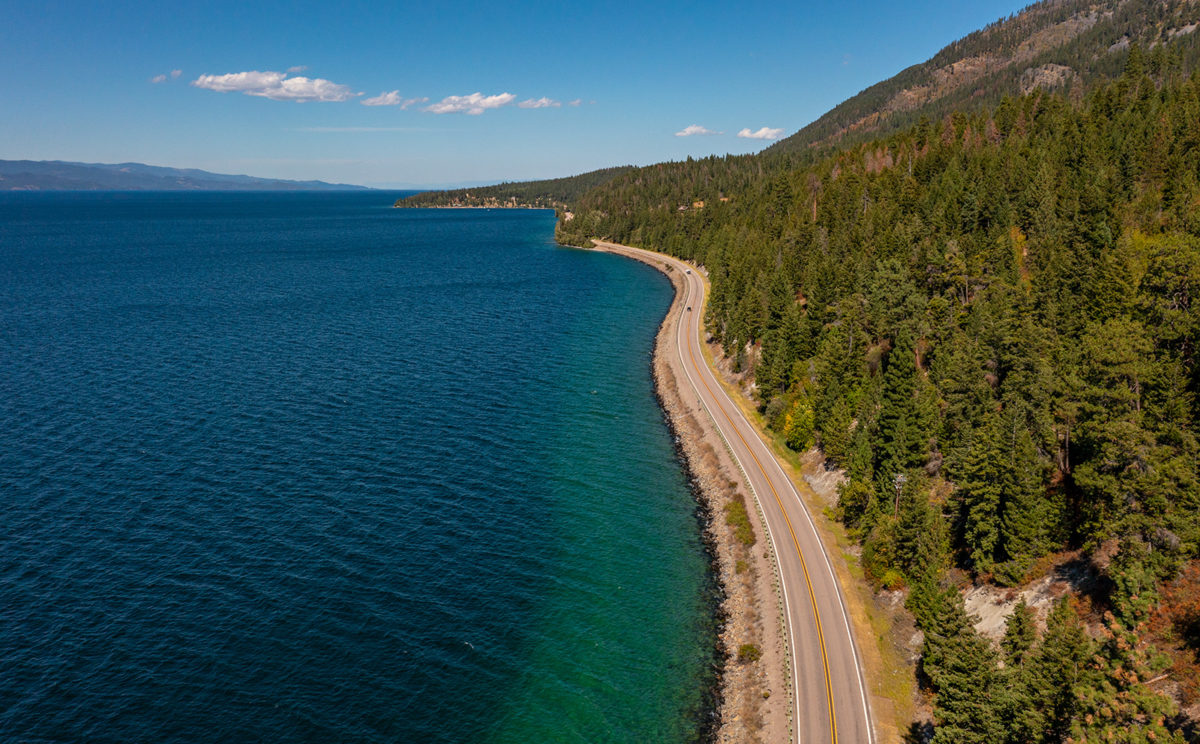
As it meanders north from Polson towards Bigfork, Montana Highway 35 can resemble an asphalt roller coaster with its deep dips, twisting turns, tight trees and flirtations with the Flathead Lake shoreline.
The current version of the road, with its skimpy shoulders, sparse guardrail and a 50-mph speed limit, carries a mix of local traffic along with SUVs, RVs and large trucks, often hauling tandem trailers. The result, especially in the tourist season, can be a mix of beguiling scenery and white-knuckle terror.
This thickly treed route, hemmed in by the steep, rocky slopes of the Mission Mountains and the lake shore, has tormented travelers for more than a century. Even in the early days of settlement in the Flathead Valley, transportation along the east shore of Flathead Lake, on foot or horseback, was difficult enough that many opted to make the trip via boat. A small fleet of steamboats operated on the lake, hauling passengers and freight between Polson and various points to the north, including Yellow Bay, Bigfork, Somers and the long-gone community of Demersville south of present-day Kalispell.


While travelers from afar could reach the upper Flathead Valley via passenger train starting in the early 1890s, and were able to venture north from Missoula to Ravalli by train even earlier, the stretch between the rail points often involved horses, wagons a boat or a very long walk.
“Flathead Lake itself served as both an obstacle and as the means of traveling north and south,” area historian Henry Elwood noted in his history, “Kalispell, Montana and the Upper Flathead Valley.” “Early settlers in the region generally found travel extremely difficult.”
Eventually, roads were constructed around the lake. Near the west shore, a road of sorts appeared in 1880 although one historian described it “as barely passable and open only seasonally.” The road saw gradual improvements in the coming decades and eventually, today’s U.S. Highway 93 took shape.
An actual road along the east shore didn’t come until more than 30 years later and it took an enterprising prison warden and the strong backs of inmates to make it a reality. A statewide movement to improve roads and accommodate increasing automobile travel took root in the first decade of the 20th century. Nationwide, the use of inmates on construction projects was increasingly common and in Montana, the idea of using convict labor gained steam.
“The chief aid of the state to the betterment of our highways can come only by working the convicts on the roads,” Montana Governor Edwin Norris proclaimed in 1910.
The so-called “good-roads” movement found support among other state officials and garnered the enthusiastic backing of Frank Conley, who oversaw the operation of the state-owned prison in Deer Lodge, part of which had been built with convict labor.


In March 1912, a crew of 40 to 50 prisoners began work on what became known as the East Shore Road. The project was launched as part of an agreement between the state, prison officials and Flathead County. The goal was to construct a road with a gravel surface, 20 to 24 feet wide, with drainage ditches on both sides. Flathead County (Lake County was not formed until 1923) agreed to provide equipment, including shovels, picks, horses, wagons and scrapers. Area businesses pitched in money for horse feed and blasting powder.
The prisoners were paid 50 cents a day for grueling manual labor. While explosives and pneumatic drills were used to break up the plentiful rock, removing the rock and creating the roadbed involved horses, strong backs and hand tools. “It was hard work on those convict gangs but there were perks that came with it,” noted Jon Axline, a historian for the Montana Department of Transportation, in a recent interview. Axline researched and wrote an in-depth article on the use of convict labor that appeared in Montana: The Magazine of Western History in 2012.
The perks on the East Shore project included good meals, lodging in tents near Flathead Lake and often evening musical entertainment. But the biggest benefit might have come in the form of being free of the poor conditions at the prison in Deer Lodge. The facility was overcrowded and lacked indoor plumbing for many years.
“I think it was a privilege to get out of there,” Axline said. Most of those who worked on the projects were doing time for theft, burglary or cattle rustling rather than violent crimes. Surprisingly, the guards who oversaw the convict laborers and camps were unarmed. On the East Shore project, the convict crew numbered as high as 111 prisoners who toiled over three construction seasons. There were just 13 escape attempts, the small number possibly a reflection of the punishment – prompt shipment back to the Deer Lodge prison.
Conley, the prison official, put a glowing light on the use of convict labor: “There in the freedom of the mountains, the petty criminal develops brain and brawn…From the brow of the burglar and bank robber drops the sweat of honest toil.”
Conley may have had more than prisoner well-being and rehabilitation in mind with his strong support of convict labor. While the prison was owned by the state, Conley and a partner operated the prison under a contract for a number of years. When deals to use convict labor were reached, at least a portion of the money landed in the pockets of the prison operators.

Later, Conley became a state highway commissioner in addition to his prison role. When picking convict-labor projects, “he decided who got to use them and who didn’t,” Axline says. “There was a definite conflict of interest in that Conley was probably making quite a bit of money off convict labor.”
After the end of World War I, former military construction equipment was made available to states. Conley, as chairman of the state highway commission, added control of equipment distribution to his force of convict crews.
“He had his own little empire for sure, not only in Deer Lodge but in Helena,” Axline says, noting there are mixed views of Conley’s historical legacy. “He was a complicated guy and either you loved him or hated him.”
While early progress on the East Shore Road was steady, a disagreement between Flathead County and the state officials about who should pay the guards stalled the project in 1913. The dispute ended with the state paying the guards.
The use of convict labor found controversy in Montana from its earliest days. Organized labor, a powerful force in parts of the state for many decades, long opposed the practice. As the demand for better roads grew, private highway contractors seeking work from the state and local governments were also critical of the prison labor program. The prison labor program ended in 1925, partially due to the powerful opposition.
More than 230 miles of state roads were built during the roughly 12 years the program was in place, including pieces of the state’s main highways. But the 27 miles of the East Shore Road completed in 1914 at a cost to Flathead County of just under $32,000 represented the longest project completed with convict labor in Montana.
The road retained its gravel surface until 1938 when the stretch from Bigfork to Yellow Bay was paved. The remaining link to Polson was not completely paved until 1949.
In 2021, an average of more than 2,500 vehicles per day used Highway 35 near Yellow Bay, roughly midway between Polson and Bigfork, with the highway largely following the tortuous route tamed by convicts more than a century ago.